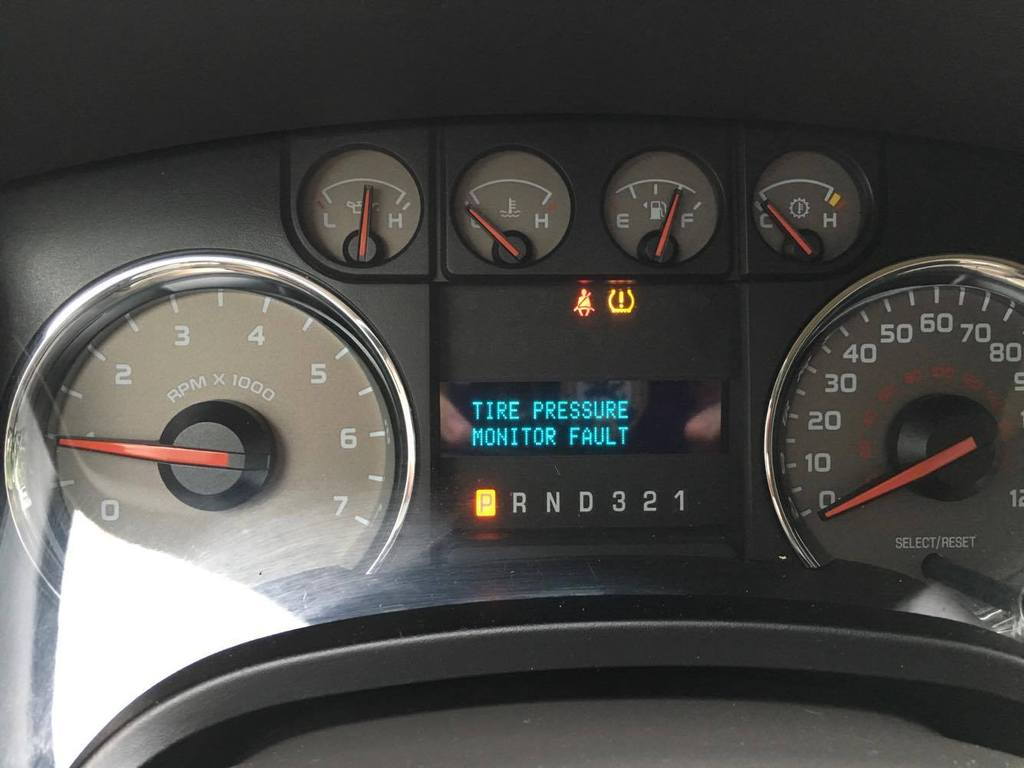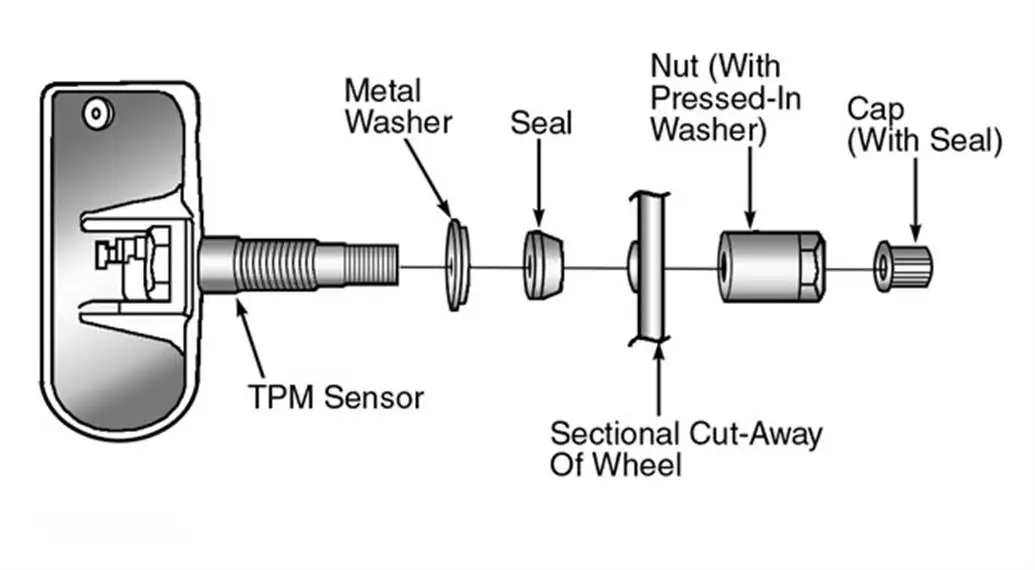Quick to follow procedure on how to reset/relearn the TPMS service maintenance indicator warning light on Pontiac G6 for the year 2008, 2009 and 2010.
A TPMS Tool, or another properly formatted TPMS scan tool, is required to perform this procedure.
Relearn Procedure for Models Equipped with Keyless Entry:
1. Set the parking brake.
2. Inflate all tires to the pressure listed on the placard.
3. Turn ignition to the ON/RUN position with the engine OFF (not the ACC position).
4. Using the keyless entry (key fob), press and hold the lock and the unlock buttons simultaneously until the horn sounds. The horn sounds twice to signal the receiver is in relearn mode and TIRE LEARNING ACTIVE message displays on the DIC
5. Select the vehicle make, model and model year in your TPMS Tool.
6. Starting with the LF tire, use your TPMS Tool to scan each sensor in the following order: LF, RF, RR and LR. The horn will chirp, after the vehicle has received a
signal from each sensor. After activating the LR tire, the horn will chirp twice signifying the relearn is complete.
7. Turn the ignition to the OFF position.
Relearn Procedure for Models Equipped with a Driver’s Information Center (DIC):
1. Inflate all tires to the pressure listed on the placard.
2. Turn ignition to the ON/RUN position with the engine OFF (not the ACC position) and lower the driver’s side window.
3. Press the Vehicle Information button (located to the left or right of the instrument cluster) repeatedly until “LEARN TIRE PRESSURES” is displayed. Then press the checkmark button
4. Select the vehicle make, model and model year in your TPMS Tool.
5. Starting with the LF tire, use your TPMS Tool to scan each sensor in the following order: LF, RF, RR and LR. The horn will chirp, after the vehicle has received a signal from each sensor. After activating the LR tire, the horn will chirp twice signifying the relearn is complete.
The horn will chirp, after the vehicle has received a signal from each sensor. After activating the LR tire, the horn will chirp twice signifying the relearn is complete.
6. Turn the ignition to the OFF position.
Relearn Procedure for Models NOT Equipped with a Keyless Entry or DIC:
1. Inflate all tires to the pressure listed on the placard.
2. Turn ignition to the ON/RUN position with the engine OFF (not the ACC position) and lower the driver’s side window.
3. Press the trip odometer button until “LEARN TIRE PRESSURES” is displayed. Then hold down the trip odometer button until the horn chirps.
4. Select the vehicle make, model and model year in your TPMS Tool.
5. Starting with the LF tire, use your TPMS Tool to scan each sensor in the following order: LF, RF, RR and LR. The horn will chirp, after the vehicle has received a signal from each sensor. After activating the LR tire, the horn will chirp twice signifying the relearn is complete.
6. Turn the ignition to the OFF position.
Relearn Procedure for Models Equipped with Keyless Entry:
1. Inflate all tires to the pressure listed on the placard.
2. Turn ignition to the ON/RUN position with the engine OFF (not the ACC position).
3. Using the keyless entry (key fob), press and hold the lock and the unlock buttons simultaneously until the horn sounds.
4. Starting with the LF tire, use a properly formatted TPMS scan tool to scan each sensor in the following order: LF, RF, RR and LR. The horn will chirp, after the
vehicle has received a signal from each sensor. After activating the LR tire, the horn will chirp twice signifying the relearn is complete.
5. Turn the ignition to the OFF position.
Relearn Procedure for Models Equipped with a Driver’s Information Center (DIC):
1. Inflate all tires to the pressure listed on the placard.
2. Turn ignition to the ON/RUN position with the engine OFF (not the ACC position) and lower the driver’s side window.
3. Press the Vehicle Information button (located to the left or right of the instrument cluster) repeatedly until “LEARN TIRE PRESSURES” is displayed. Then press the checkmark button.
4. Starting with the LF tire, use a properly formatted TPMS scan tool to scan each sensor in the following order: LF, RF, RR and LR. The horn will chirp, after the vehicle has received a signal from each sensor. After activating the LR tire, the horn will chirp twice signifying the relearn is complete.
5. Turn the ignition to the OFF position.
Relearn Procedure for Models NOT Equipped with a Keyless Entry or DIC:
1. Inflate all tires to the pressure listed on the placard.
2. Turn ignition to the ON/RUN position with the engine OFF (not the ACC position) and lower the driver’s side window.
3. Press the trip odometer button until “LEARN TIRE PRESSURES” is displayed. Then hold down the trip odometer button until the horn chirps.
Then hold down the trip odometer button until the horn chirps.
4. Starting with the LF tire, use a properly formatted TPMS scan tool to scan each sensor in the following order: LF, RF, RR and LR. The horn will chirp, after the vehicle has received a signal from each sensor. After activating the LR tire, the horn will chirp twice signifying the relearn is complete.
5. Turn the ignition to the OFF position.
The Pontiac G6 is a mid-size car that was produced by General Motors under the Pontiac brand. It was introduced in 2004 for the 2005 model year to replace the Grand Am. The car was built on the GM Epsilon platform which it shared with the Chevrolet Malibu and Saab 9-3 along with other General Motors vehicles. Features included a remote starting system (standard on GT, optional on base model), traction control/ABS, electronic stability control, automatic headlights as well as a panoramic sunroof option. Production ended in 2010 with the discontinuation of the Pontiac line. (Source Wiki)
(Source Wiki)
Tags: Pontiac, Pontiac G6, Relearn, Reset, tpms
Christ Posted on Posted in Tips No Comments Tagged with 2010 Pontiac G6, Pontiac G6 Tire Pressure, Pontiac G6 Tire Pressure System, Pontiac G6 TPMS Light, Pontiac G6 tpms reset, Pontiac Tire Pressure Reset, Tire Pressure system reset
Last Updated on February 14, 2020 by Christ
Pontiac G6 TPMS Light Tire Pressure Sensor System Reset (2008-2010) – The G6 is a mid-size car produced by Pontiac from 2004 to 2009. It was introduced in late 2004 as a replacement for the Grand Am. The model was assembled at Lake Orion, Michigan on General Motors’ Epsilon floor, and had the front-mounted engine. The traction was also the front. The G6 shared the Epsilon platform, among other things, with the Chevrolet Malibu and the Saab 9-3. The style of the model was conventional, and the grooved inserts and rear flaps that were characteristic of the Grand-Am were replaced by the most common type of sheet metal. Optional equipment included a remote ignition system (standard on the GT and optional on the base version), traction control, ABS, electronic stability control, automatic front lights and panorama roof.
The style of the model was conventional, and the grooved inserts and rear flaps that were characteristic of the Grand-Am were replaced by the most common type of sheet metal. Optional equipment included a remote ignition system (standard on the GT and optional on the base version), traction control, ABS, electronic stability control, automatic front lights and panorama roof.
In essence, the G6 was the sixth Grand-Am series. The name was changed to favor the repositioning of Pontiac as a BMW rival. This new type of nomenclature was also the basis for the models that were launched later on. For example, the Pontiac G8 would belong to a higher class, while the Pontiac G5 would be part of a lower class. The Pontiac G6 was introduced for the first time in 2003 as a concept car at the Detroit Car Show. This concept car had installed a V6 engine powered by 3.5 l displacement and 285 hp of power. It was coupled to an electronically controlled 4T65-E automatic transmission.
Contents
 0.0.1 Tools
0.0.1 ToolsTime Needed : 7 minutes
If you replaced a wheel, tire, TPMS sensor, etc. and are now getting a warning light on your car, then the sensor needs to be reset. To relearn, turning off or reset the Tire Pressure Monitoring System (TPMS) light on your Pontiac G6, follow these steps:
Press the INFO and Set/Reset buttons at the same time until the TIRE LEARN? message displays on the Driver Information Center
When a message requesting acceptance of the process appears, press and hold the Set/Reset button again to confirm.
The horn sounds twice to signal the receiver is in relearn mode
For more details, please watch the following video:
This tutorial is based on the Pontiac owner’s manual. This procedure should be work on the old generation of Pontiac G6 (2008 2009 2010 model years). Hopefully the article of Pontiac G6 TPMS Light Tire Pressure Sensor System Reset (2008-2010) useful for you. Good Luck!
Hopefully the article of Pontiac G6 TPMS Light Tire Pressure Sensor System Reset (2008-2010) useful for you. Good Luck!
Name
Comment
1 2 3
